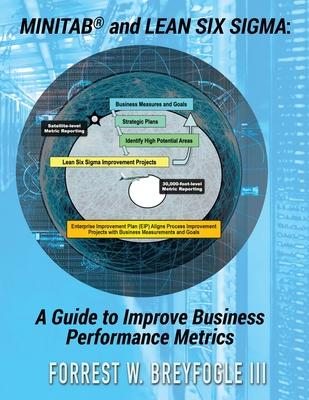This 377 page book
- Shows the execution of Minitab functions in a detailed Lean Six Sigma Define-Measure-Analyze-Improve-Control (DMAIC) roadmap to enhance the Y response for process improvement projects
- Shows use of a free software app for response-metric tracking that provides insight not possible with traditional metric reporting techniques
- Utilizes over 50 datasets to illustrate Y-response tracking from a process-output perspective and Y=f(X) analyses
- Discusses over 200 figures that illustrate software inputs and outputs
- Provides a clickable Lean Six Sigma Define-Measure-Analyze-Improve-Control (DMAIC) process-improvement roadmap that integrates the application of Lean and Six Sigma tools so that the right tool is used at the right time when undertaking process improvement efforts
- Shows a methodology for Lean Six Sigma improvement project selection so that the organization's big-picture benefits from the project′s completion
- Provides a method to statistically show and quantify at the 30,000-foot-level the benefits of process improvement efforts
- Offers a business process improvement system that goes beyond traditional Lean Six Sigma and the Balanced Scorecard
- Explains a method for executing and enhancing digital transformation efforts in an organization
This book provides direction on how organizations can resolve issues that commonly occur with:
- Traditional control charts and process capability reporting techniques
- AQL testing and reporting
- Lean Six Sigma deployments
This book provides direction on how organizations can benefit from the wise application of:
- Statistical and non-statistical techniques.
- Design of Experiments (DOE) in both manufacturing and transactional processes.
This book provides a comprehensive 9-step system that CEOs, presidents, general managers, executives, managers, leaders, practitioners, and others can use to resolve elephant-in-the-room management issues such as:
- Business goals not being met
- Scorecards leading to harmful, if not destructive, behaviors
- Persistent day-to-day firefighting problems
- Business strategies that are very generic and difficult to translate into organizational work environments
- Lean events and other improvement projects can consume many resources but often do not offer a quantifiable benefit to the business as a whole
- Lean Six Sigma process improvement deployments that have improvement projects, which are either not completed in a timely fashion or which make substantial financial claims that are questionable
This book describes the application and how to use of the following tools in Minitab as part of a Lean Six Sigma Define-Measure-Analyze-Improve-Control (DMAIC) roadmap
- Time-series plot
- Histogram
- Dot plot
- Descriptive statistics
- Pareto chart
- Probability plot
- X-bar and R control chart
- P-chart
- Process capability indices
- 30,000-foot-level reports
- Cause-and-effect diagram
- Visualization of data
- Multi-vari chart
- Hypothesis testing
- Inferences: continuous data
- Inferences: attribute data
- Comparing two samples
- Demonstration of process metric output response improvement
- Variance components
- Correlation
- Simple regression
- Residuals
- Single factor ANOVA
- ANOM
- Two factor ANOVA
- Multiple regression
- Binary Logistic regression
- General Linear Model (GLM)
- Design of Experiments (DOE)
- Response surface methodology (RSM)
- Control phase - maintain the gain
Offers a methodology to implement Deming's management philosophy, ISO 9000, Baldrige award criteria & Shingo Prize criteria.
